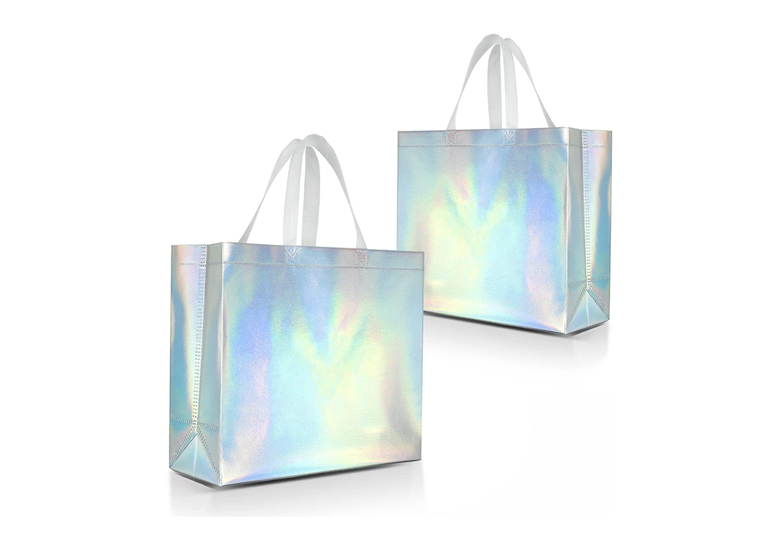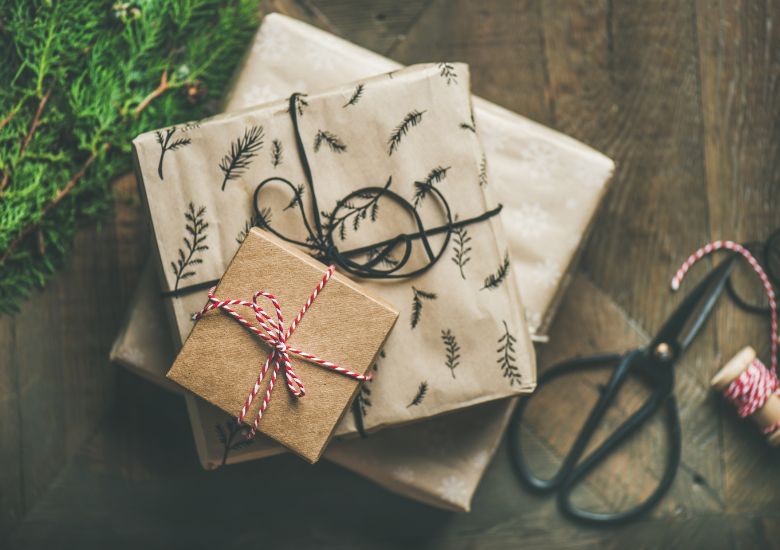
The festive season is synonymous with joy, celebration, and gift-giving. However, beneath the shimmering lights and colorful wrappings lies an often-overlooked environmental concern: wrapping paper. The holiday season, particularly Christmas, sees a significant surge in waste generation. Don’t worry – I’m guilty of it too! From the Christmas gifts we exchange to the food we prepare, the environmental footprint is substantial. According to a report by CNN, Americans discard approximately 25% more trash between Thanksgiving and New Year than any other time, resulting in an additional 25 million tons of garbage. This waste isn’t just limited to food leftovers or broken decorations; a significant portion comes from gift wrappings.
The tradition of wrapping presents, while delightful, has a darker side. Stanford University states that if every family in the U.S. wrapped merely three presents with reused materials, it could save enough paper to cover a staggering 45,000 football fields. Such statistics underscore the pressing need to reconsider our holiday habits. As we indulge in the spirit of giving, it’s crucial to also think about the planet we inhabit. By making informed choices, such as opting for sustainable wrapping methods or reducing food waste, we can ensure that our celebrations don’t come at the expense of the environment. As we approach the festive season, let’s pledge to make it not just merry but also eco-friendly.
As your trusted Shopping Editor at Heavy on Shopping, I’ve always been here to help you find the best presents for your loved ones. Today, I’m throwing on a slightly different hat, guiding you through the maze of Christmas wrapping paper and its recyclability. After all, the wrapping is the first impression of your thoughtful gift, and we want it to be both beautiful and eco-friendly! But there’s a problem…
4.6 Million Pounds of Wrapping Paper Every Year
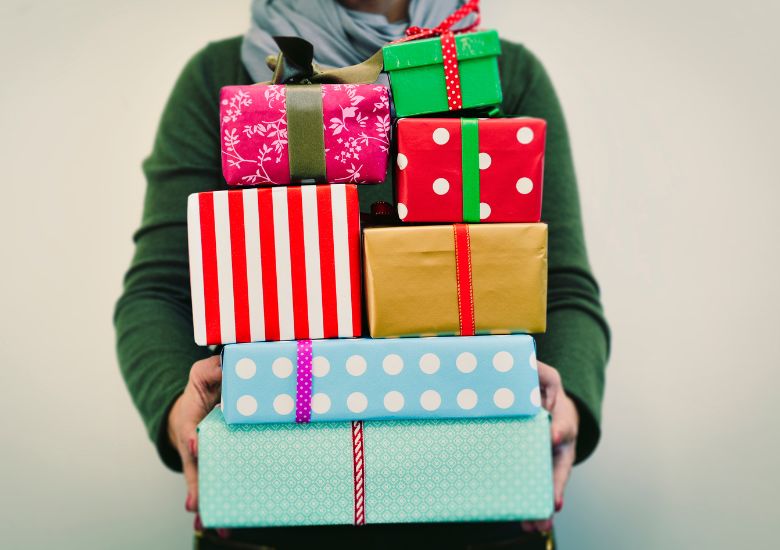
The U.S. is estimated to produce a staggering 4.6 million pounds of wrapping paper every year. What’s even more concerning is that approximately half of this—around 2.3 million pounds—finds its way to landfills.
But why is Christmas gift wrap a problem? The answer lies in its composition. Many wrapping papers are adorned with glitter, metallic finishes, or plastic laminations, which make them non-recyclable. Even those that appear recyclable often get contaminated with tape, ribbons, or other non-paper accessories, rendering them unsuitable for recycling. As a result, most of this paper, which could have been recycled, ends up as waste.
The production of wrapping paper itself has environmental implications. The paper industry is one of the major contributors to deforestation. Trees, which act as carbon sinks, are cut down to produce paper, leading to increased carbon dioxide levels in the atmosphere. The production process also consumes vast amounts of water and releases harmful chemicals into the environment.
Another aspect to consider is the cultural shift towards extravagant gift-wrapping. The societal pressure to give our gifts in an attractive presentation has led to an increase in the use of accessories like bows, ribbons, and tags. While these additions enhance the aesthetic appeal of the gift, they also contribute to the growing waste problem. Ribbons and bows, often made of synthetic materials, are rarely reused and end up as trash.
However, it’s not all gloom and doom. Many individuals and organizations are recognizing the environmental impact of Christmas gift wrap and are taking steps to address it. Eco-friendly wrapping options, such as cloth wraps, reusable bags, and biodegradable papers, are gaining popularity. There’s also a growing trend of “upcycling” – using old newspapers, maps, or magazines as wrapping paper. Such initiatives not only reduce waste but also add a personal touch to the gifts.
The Best Eco-friendly Alternatives

Fear not, eco-conscious gift-givers! There are plenty of sustainable alternatives. Consider using brown craft paper, which is both recyclable and compostable. You can jazz it up with natural elements like twine, dried flowers, or even hand-drawn designs. Cloth wraps, old newspapers, and reusable gift bags are also fantastic options.
So, without further ado, let’s unwrap (pun absolutely intended!) some sustainable wrapping solutions below.
1. Reusable Cloth Wraps (Furoshiki)
Originating from Japan, Furoshiki is the art of wrapping gifts using cloth. These wraps can be reused year after year, making them a sustainable choice. Plus, with a variety of fabrics and patterns available, they add an elegant touch to your gifts. The best part? The recipient can repurpose the cloth in numerous ways, from a chic scarf to a handy tote.
How-to Tip: Place your gift in the center of the cloth. Fold the cloth over the gift and tie the opposite ends together. You can also get creative with different folding and tying techniques for a unique look.
2. Brown Craft Paper
Simple, rustic, and 100% recyclable, brown craft paper is a versatile wrapping option. It provides a blank canvas, allowing you to unleash your creativity. You can even go a step further and buy Eco Kraft Wrapping Paper which is made from a biodegradable recyclable material. But also, you can walk into JoAnn’s or
How-to Tip: After wrapping your gift, consider stamping the paper with festive designs, drawing doodles, or even writing a heartfelt message. Pair it with twine and natural elements like dried flowers or pinecones for a rustic finish.
3. Old Newspapers and Magazines
Before you toss out those old newspapers and magazines that are in that green bin in your garage that you’ll never clean out, consider repurposing them as gift wrap. Not only is this method eco-friendly, but the varied prints also add a vintage charm to your gifts.
How-to Tip: Choose pages with colorful images or interesting typography. For added flair, combine different pages and secure them with washi tape.
4. Reusable Gift Bags
Invest in reusable gift bags (these bags from Nush Nush are the best I’ve tried) made of fabric or durable materials. These bags can be used multiple times, reducing waste. Plus, they come in various sizes, designs, and colors, catering to all your gifting needs. They even have iridescent bags!
5. Mason Jars
Perfect for gifting homemade treats, candles, or bath salts, Mason jars are both functional and eco-friendly. They can be reused in numerous ways, from storage containers to decorative pieces.
They even have colored, rainbow gradient mason jars that are PERFECT for gift-giving.
In fact, I honestly stole this idea from my wife’s Aunt. Every year, her Aunt gives us a large Mason jar filled with homemade chocolate turtles and peanut butter balls, and it’s perfect!
How-to Tip: Decorate the lid with a piece of cloth or craft paper. Secure it with twine and add a handwritten label.
6. Biodegradable Wrapping Paper
Several brands now offer wrapping paper made from sustainable sources that are biodegradable. These papers come in beautiful designs and are an excellent alternative to traditional gift wraps.
Paper Farm has a highly-rated Eco Kraft Wrapping Paper Roll that is a giant (100ft) paper roll that’s 100% biodegradable and recyclable.
There are actually entire companies dedicated to creating eco-friendly wrapping paper. One of which is called Wrappily, which uses recycled newspapers to create great-looking eco-friendly wrapping paper that is NOT the tan and green you are expecting. They’re actually quite colorful and probably the closest thing you’ll find to traditional wrapping papers.
How-to Tip: Pair with natural twine or hemp cord instead of plastic ribbons for a fully sustainable wrapping solution.
7. Tote Bags

Tote bags are not only eco-friendly but also serve as a bonus gift. Choose from various materials like cotton, these jute bags, or canvas.
How-to Tip: Place your gift inside the tote and tie the handles with a ribbon. Add a sprig of holly or mistletoe for a festive touch.
How to Determine If Your Christmas Gift Wrap is Recyclable
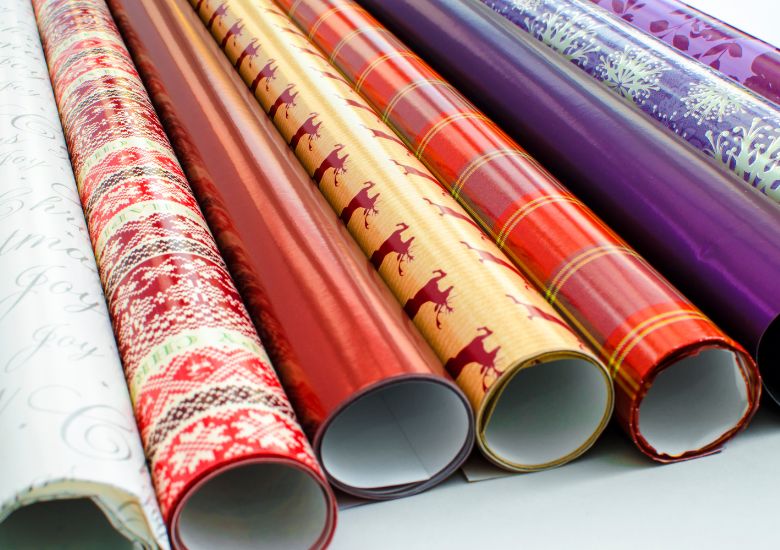
Now, if you’re anything like me, you’ve probably spent hours choosing the most dazzling wrapping paper, ensuring your gifts look Christmassy AF on the outside. But here’s a little secret: the glitzier the paper, the less likely it is to be recyclable. Shocking, right?
Is your Christmas wrapping paper recyclable?
Use The Trusty ‘Scrunch Test’
Here’s a quick trick I’ve learned over the years of furiously wrapping Christmas presents the night before: the scrunch test. Take a piece of your wrapping paper and scrunch it into a ball. If it stays scrunched, it’s likely recyclable. If it unfolds or retains a smooth texture, it’s probably not. This test isn’t foolproof, but it’s a good starting point.
The Glittery Culprit
We all adore that shimmering, glittery wrapping paper. It screams festive and adds a touch of magic to our gifts. However, most glittery wrapping papers are non-recyclable. The tiny specks of glitter are often made of microplastics, which are not only non-biodegradable but can also contaminate other recyclable materials.
Metallics and Laminations
Metallic finishes and plastic laminations, while giving a luxurious feel to your gifts, are recycling nightmares. These materials prevent the paper from being broken down during the recycling process. So, if it’s shiny and reflective, it’s probably best to avoid it if you’re aiming for a green Christmas.
Ribbons, Bows, and Tapes
These little accessories, while adding pizzazz to your gifts, can be problematic. If you’re using recyclable paper, ensure you remove any ribbons, bows, or tapes before tossing them in the recycling bin. These accessories can contaminate recyclable materials, rendering them useless.
The Environmental Impact of Choosing Sustainable Wrapping Options
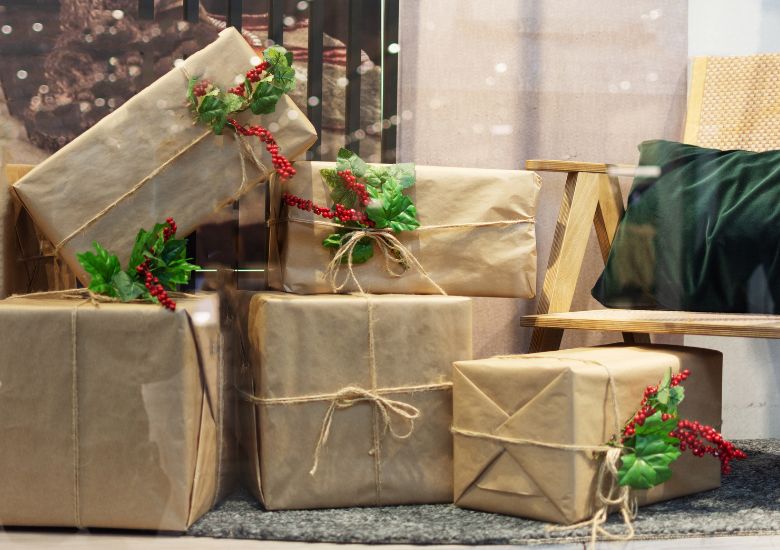
As your dedicated editor of Heavy on Shopping and thousands of gift guides, I believe it’s crucial to understand the impact of our decisions. So, let’s delve into the environmental benefits of choosing sustainable wrapping options.
Reduction in Landfill Waste
Traditional wrapping papers, especially those laden with glitter, metallic finishes, or plastic laminations, often end up in landfills. By opting for recyclable or reusable wrapping options, we significantly reduce the volume of waste that finds its way to these sites. Remember, landfills are not just unsightly; they produce methane, a potent greenhouse gas that exacerbates climate change.
Lower Carbon Footprint
The production of conventional wrapping paper involves cutting down trees, consuming vast amounts of water, and using energy-intensive processes. By choosing sustainable alternatives, we reduce the demand for such papers, subsequently lowering our carbon footprint. Every tree saved means more carbon dioxide is absorbed from the atmosphere!
Conservation of Resources
Water is a precious resource, and the paper industry is notoriously water-intensive. By reducing our reliance on traditional wrapping paper, we contribute to water conservation. Moreover, sustainable wrapping options like cloth wraps or reusable bags can be produced with significantly less water and energy.
Reduction in Chemical Pollution
The paper bleaching process releases harmful chemicals into our waterways, affecting aquatic life and contaminating water sources. Sustainable wrapping papers, especially those made from organic materials or recycled content, often bypass this bleaching process, leading to fewer chemicals in our environment.
Biodiversity Protection
Forests are not just carbon sinks; they are also home to a myriad of species. The paper industry’s demand for wood often leads to deforestation, threatening the habitats of countless animals and plants. By choosing eco-friendly wrapping options, we indirectly support biodiversity conservation.
Promotion of Sustainable Industries
Every time we purchase a sustainable product, we support industries and businesses committed to eco-friendly practices. This not only boosts the green economy but also encourages other businesses to adopt sustainable practices.
Encouraging Mindful Consumption
Opting for sustainable wrapping is not just an eco-friendly act; it’s a statement. It signifies a shift towards mindful consumption, where we consider the lifecycle of a product, from production to disposal. This mindset, when adopted by many, can lead to significant positive changes in our consumption patterns.
Setting a Trend
Never underestimate the power of leading by example. When friends and family see your beautifully wrapped, eco-friendly gifts, it sparks curiosity and often inspires them to adopt similar practices. In this way, the trend of sustainable wrapping can spread, amplifying its positive impact.
As we tie the bow on our exploration of sustainable gift wrapping, it’s evident that the choices we make during the festive season have profound implications. The act of giving, deeply embedded in the spirit of Christmas, is a testament to our love and appreciation for our loved ones. But, as your ever-passionate Gift Guide Editor, I urge you to remember another recipient of our actions: our beautiful planet.
By choosing sustainable wrapping options, we’re not just making an eco-friendly choice; we’re weaving sustainability into our festive traditions.
The beauty of sustainable gift wrapping lies in its simplicity and creativity. Whether it’s repurposing old newspapers, embracing the elegance of Furoshiki, or crafting personalized wrapping paper with potato stamps, each method tells a story. It’s a story of love, care, and a deep-rooted respect for the environment.
I mean, you’re still going to be scrambling on Christmas Eve to wrap everything all at once, but at least you’ll be eco-friendly about it this year!
Moreover, sustainable wrapping isn’t just a once-a-year endeavor. The principles we’ve discussed can be applied to other occasions, from birthdays to anniversaries. It’s a lifestyle choice, one that resonates with the growing global emphasis on sustainability.
In the grand tapestry of Christmas celebrations, gift wrapping might seem like a small detail. However, when millions of people around the world make eco-conscious wrapping choices, the collective impact is monumental. It’s a ripple effect, where one sustainable choice leads to another, creating waves of positive change.
So let’s make a conscious decision to wrap our gifts with love, not just for the recipient but also for the planet. We should all embrace more sustainable practices, not as an alternative but as the norm. And as we gather around the Christmas tree, with gifts wrapped in eco-friendly materials, we can take pride in knowing that our celebrations are a gift to the Earth.

